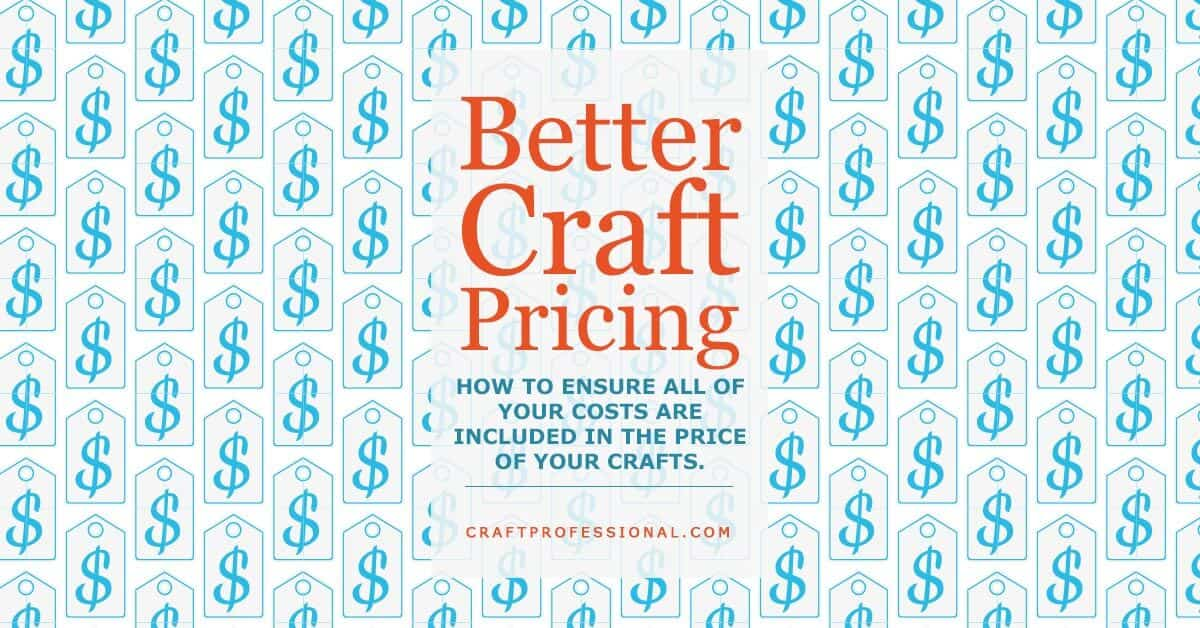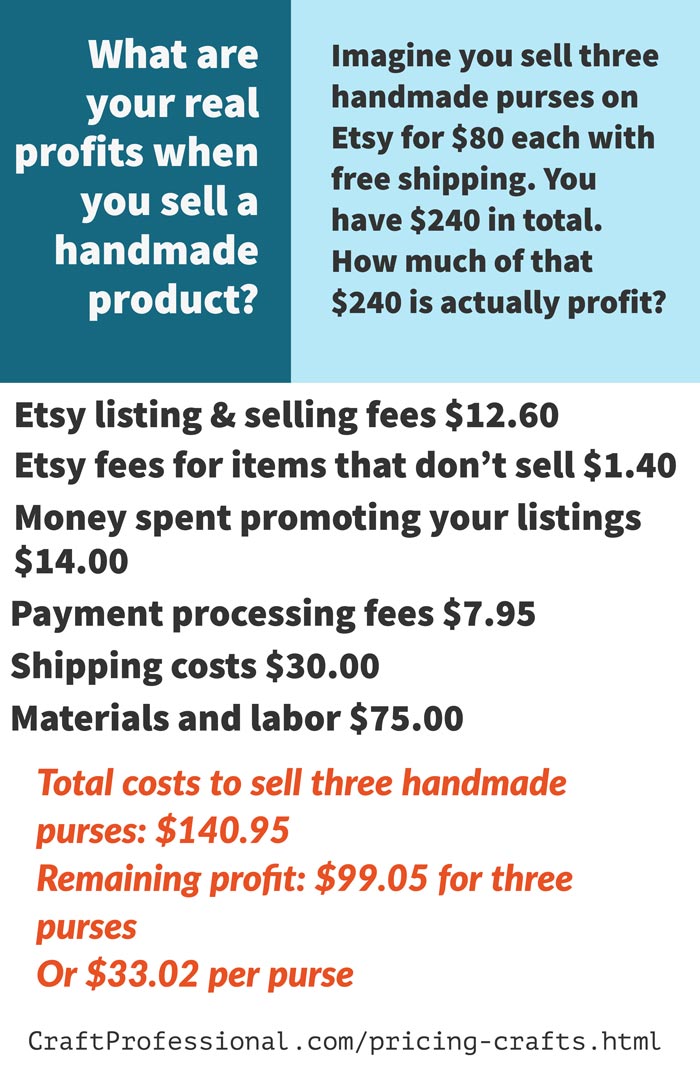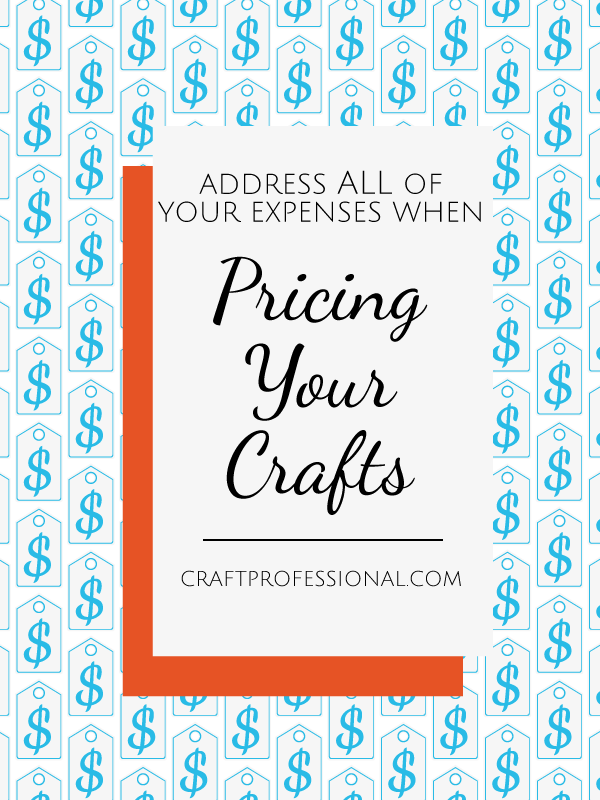Pricing Crafts to Address All of Your Costs
When you're pricing crafts, do you really take the time to think through all of the costs involved in creating an item?
You should.
And if you don't, you might be very surprised by what you discover.
When you really start to do some analysis, it's amazing how quickly your expenses add up and how much you actually need to charge to make a fair profit.

I earn a commission for purchases made through links on this page.
To learn more, please see my disclosure.
To help convince you that you're not doing yourself or your business any favors by pricing crafts at unreasonably low prices, here's some math to show you how expenses can impact profits.
The Real Cost To Sell a Handmade Item
Imagine you're selling handmade purses on Etsy.
To keep things a bit simple, I'll assume you're charging $80.00 for each purse, and you offer free shipping.
Let's say you have sold three purses on Etsy. You're doing a happy dance. Woohoo, $240!
But how much profit have you actually made?
Definitely not $240
As of this writing, you'll owe Etsy 20¢ for the listing fee and $4.00 for the transaction fee (5% of the selling price) for each $80.00 purse you sell.
That works out to $4.20 for each purse that sold, or $12.60 for all three purses. You keep $75.80 per purse, or $227.40 for all three sales.
If you charged separately for shipping, you'd also owe Etsy 5% of the shipping fees your customer paid.
So, if you sell three purses on Etsy, you might think, "Hmm, not bad, once I subtract the selling costs, I've made $227.40."
Well, not quite.
Don't Be Too Quick to Count Your Profits!
Factor in the Cost to List All of Products, not only the ones you sold
Keep in mind you won't typically sell all of the purses you have listed.
Your Etsy listing fee of 20¢ pays a four month listing. If your item doesn't sell in those four months, you need to renew the listing for another 20¢ to keep it in your Etsy shop.
Imagine 30% of your handmade purses that are listed actually sell over a four month listing period. That means, if you sold 3 purses, you must have had 10 purses listed. So you also owe Etsy 20¢ for each purse that didn't sell, or another $1.40. Now you can say you've made $226.00.
What Have You Spent to Promote Your Shop?
A common strategy for promoting items on Etsy is to renew items more frequently than every 4 months. Newer listings are thought to rank better in Etsy's search results.
So, imagine, instead of renewing your items once every four months, you renew your items 8 times in 4 months (approximately every 2 weeks).
If you have 10 purses for sale, that would be an extra cost of $1.40 per purse, or $14.00 for all purses, including the ones that didn't sell. Once you subtract the money you spend to promote your Etsy shop, you're at $212.00.
Don't forget your payment processing fees
We'll assume you use Etsy Payments to process transactions in your shop. At their rates for people with a US bank account, you'd be charged 25¢ for each transaction, plus 3% of the the payment amount. That comes to $2.65 per purse, or $7.95 for all three purses.
Now you're down to $204.05 profit for your three purses.
That still might sound great, but it depends on what your other costs were.
Factor in your Shipping Costs
You offered free shipping to your customers because you've read that high shipping costs can hurt your sales more than a higher product price.
That's a smart strategy, as long as you remember that shipping isn't actually free. You need to factor the cost of shipping into your craft pricing if you're going to offer "free" shipping.
If shipping each purse will cost $10, that's another $30 to subtract from your profit. Now we're at $174.05 in profit.
What does it cost to make your product?
Imagine each of the three purses you sold took 60 minutes to make and used $10.00 worth of materials. (You must be extremely efficient and have a great source for raw materials!)
If you pay yourself $15.00 per hour to make the purses, that works out to a $25.00 expense per purse ($75.00 for all three purses) for time and materials.
In that case, your profit now sits at $99.05 for all three purses ($33.02 per purse), which is still pretty good. If you don't use a production assistant, the $15 per hour labor expenses will also go in your pocket. In that case, you'd end up with $48.02 in your pocket for each purse you sold.
Recap - How Did we get from to $240.00 Down to $99.05?
You sold 3 purses on your Etsy shop for $80 each or a total of $240.00. Then you subtracted your expenses:
- Selling fees of $12.60 take your profit down to $227.40
- Minus $1.40 to list other items that didn't sell in your shop = $226.00
- Subtract $14.00 in extra listing fees paid to promote your shop, and you're at $212.00
- Payment processing fees cost you $7.95, so now you're down to $204.05
- "Free" shipping cost you $30, and now we're at $174.05
- There was $75.00 for time and materials, and your profit now sits at $99.05 or $33.02 per purse
That's still a good profit, but it's far from the $80 per purse you charged, and these calculations don't even take into account other expenses like business insurance, tools, or supplies needed to run your studio. That overhead may contribute another 10-15% of your costs.
That's still a good profit, but it's far from the $80 per purse you charged, and these calculations don't even take into account other expenses like business insurance, tools, or supplies needed to run your studio. That overhead may contribute another 10-15% of your costs.

What's the Danger in Pricing Crafts at a Lower Level as a Strategy to Attract More Customers?
Imagine you've fallen into the mindset of pricing crafts to compete on price and trying to profit on very slim margins. You've decided to sell the same purses for $40 each instead of $80 to try to sell more.
Here's how the numbers work out if you sold the same three purses at $40 each (or $120 in total):
- Selling fees for the three purses that sold - $7.60
- Listing fees for the seven purses that didn't sell - $1.40
- Cost of extra listing fees to promote your shop over 4 months - $14.00
- Etsy Payment transaction fees for the three purses that sold - $4.35
- Labor and materials cost to make all three purses - $75.00
- Total Costs - $102.35
Assuming you sold each purse for $40.00, you'd have $120.00 for selling all three purses.
Once you subtract your costs, you end up with just $17.65 in profit for three purses, or $5.88 per purse.
If you don't have a production assistant, you'd get to keep the $15 per hour labor fee, which makes this a better deal for you. However, if you assume you will always do all of the labor yourself, you may truly struggle to grow your business beyond a certain point.
Also, keep in mind we haven't factored in the overhead involved in running your business, that may reasonably come to 10%, or another $12 off you $120 for the three purses at $40.
As a Craft Artist, When You Compete on Price, You End up Working a Lot Harder for a Lot Less
Let's recap and look at what these two sets of calculations tell us.
If you sell your handmade purses for $80 each, you end up with $33.02 per purse once you account for your expenses (plus $15 for labor if you don't have an assistant).
If you price your handmade purses lower - $40 each - to try to attract more customers, you end up with $5.88 per purse once you account for your expenses (plus $15 for labor if you don't have an assistant).
That's a difference of $27.14.
In other words, when you sell a single purse for $80, you end up with $27.14 in profit more than you would have if you sold your purse for $40.
You cut the price of your purses in half, but you've cut your profits far more drastically than that.
How does that translate into your goal to make more by selling more at lower prices?
If you cut prices with a goal to sell more purses, you'd have to sell almost 6 purses at $40 to equal the profit from a single purse sold at $80.
Of course, the labor expense complicates the issue. Some craft business owners don't like to include labor in their costs because, they figure, if you don't have an assistant, that money goes in your pocket.
However, if you don't build room for labor expenses in your prices, you won't have room to hire support if that becomes the next logical step in growing your business.
You may think hiring support seems unrealistic, or unlikely. However, you might be surprised when you reach a point at which a production assistant who helps with simpler elements would help you reach demand or participate in larger craft shows. Or, you might need a marketing assistant who manages your business' social media and other online promotions to help you grow your online business while you focus on the design and production of your products.
If you haven't left room in your prices to hire that type of support, your business may hit a wall at which it's tough to grow beyond.
A Craft Pricing Formula Ensures You've considered all of Your Costs
This craft price calculator will help you determine whether you're pricing crafts to reflect all of your expenses and leaving room for growth.
What's Wrong with $5.88 in Profit?
The problem with that number is that is doesn't reflect the true profit to your business, and it doesn't leave room to grow.
In all of these calculations, we didn't even account for overhead costs, and we didn't account for all of the time it takes to run and promote your business separate from creating your products.
Also, at a $40 selling price, it's impossible to wholesale your products to retailers who expect to buy multiples of your product at half of the retail price. Based on the number above, you cannot sell your purses profitably at a $20 wholesale price, even if you eliminate some of the selling expenses in the calculations above.
Plus, you're going to have to keep up a very busy pace in order to make a significant amount of money when your profit is only $5.88 per purse.
Pricing crafts at a small profit margin doesn't work because you need to sell high volume to make up for slim profits. That's a tough thing to do when you have to devote a certain amount of time to create each product.
Unless you sell something like a digital product that you can create once and sell multiple times, (patterns, or printable art, for example) craft businesses just don't scale in a way that makes low pricing a viable option.
Imagine you made and sold $40 handmade purses on a full time basis
If each purse takes one hour to make, and you work at your business full time, you might spend 30 hours a week making purses (at one per hour, that's 30 purses) and 10 hours a week managing and promoting your business.
We'll assume you manage to sell all 30 purses. (That is a huge assumption, but I don't want to make this scenario more complex.) If each purse sold for only $40 each, you'll end up with only $174.90 in profit. While it's always nice to have an extra $175 in your pocket, it really is a lot of work for a little money.
If, instead, you sold your purses at $80 each ($33.02 profit per purse), you'd end up with a profit of $990.60 for the same amount of effort.
Again, there's the labor cost as well that might end up in your pocket. That works out to $450 for 30 purses at either selling price.
Key Takeaways
I hope this look at pricing crafts to factor in all of your costs hasn't completely depressed you. That wasn't my intention at all.
I hope it has caused you to look very closely at what it would take to make your business profitable. I also hope it has dissuaded you from under pricing your crafts to try to sell more.
When you make handmade items, you're going to spend a fixed amount of time creating your items and a fairly fixed amount of money buying your supplies. Once you've become as efficient as possible, that won't change. It's simply the nature of selling handmade goods.
So, instead of spending your time creating low-value items that sell for a lower profit, why not put in the time and effort required to create items that have a high perceived value in the minds of your customers?
If you don't know where to start to make changes that will allow you to command higher prices, I'd recommend James Dillehay's book, How to Price Crafts and Things You Make to Sell.
If you've spent a good part of your time reading this article and thinking, "That's lovely in theory, but customers won't pay such high prices for my products." James Dillehay will show you what you can do to raise the perceived value of your product and command the prices you need to charge to be profitable.
No matter what you make, you're going to spend a fixed amount of time making your items. Why not make and market something that produces a good profit on the time you invest?



New! Comments
Have your say about what you just read! Leave me a comment in the box below.